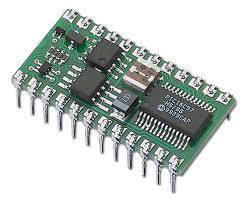 BLOK DIAGRAM MONITOR
BLOK DIAGRAM MONITORSebelum menginjak ke pembelajaran troubleshooting monitor CRT berikut ini akan saya coba gambarkan diagram blok dari monitor CRT. coba baca dan lihat serta cermati bagan dibawah ini :
klik pada gambar untuk memperbesar gambar ......

1. BLOK VIDEO / RGB :
a. VIDEO INPUT : masukan sinyal yg biasanya didapat dari VGA monitor, sinyal ini terbagi menjadi sinyal merah (RED), sinyal hijau (GREEN), dan sinyal biru (BLUE).
b. VIDEO AMPS : bagian yang berfungsi menguatkan sinyal video yang didapat dari VGA dan di bagian ini terdapat pengaturan kontras.
c. VIDEO DRIVER : bagian ini berfungsi untuk pengaturan warna drive (gambar), dan pengaturan warna background layar.
2. SYNCRONISASI GAMBAR
a. Syncrone Input (Horisontal dan Vertikal Syncrone dari VGA Card) oleh IC Sinkron
b. Clamper (Rangkaian Penggenggam / pembawa sinyal video) oleh IC Sinkron
c. Syncrone Out Put (Masuk ke rangkaian Vertikal dan Horisontal)
3. VERTIKAL
a. Vertikal Oscilator (oleh IC Vertikal)
b. Vertikal Driver (oleh IC Vertikal)
c. Vertikal Amplifier (oleh IC Vertikal)
d. Vertikal Out Put (Masuk ke Vertikal Defleksi Yoke)
4. HORISONTAL
a. Horisontal Oscilator (oleh IC Oscilator Horisontal)
b. Horisontal Driver (oleh Transistor)
c. Horisontal Amplifier (oleh Transistor Horisontal)
d. Horisontal Out Put (Masuk ke Horisontal Defleksi Yoke dan Pin 1 FLYBACK)
5. POWER SUPPLY UNIT
a. AC Input (dari PLN)
b. Penyearah dan Filter (oleh Dioda dan Elco)
c. Rangkaian Triger (oleh IC Triger / pembangkit sinyal)
d. Converter tegangan tinggi (oleh FET dan STR)
e. Transformator StepDown (Penurun Tegangan)
f. Rangkaian Out Put (oleh dioda, elco, dan IC)
6. TABUNG CRT
a. Filament / Heater (Pemanas Elektron)
b. Katoda R, G, dan B (Penghasil elektron)
c. G1 (Brightnes)
d. G2 (Screen)
e. G3 / G4 (Fokus)
f. Anoda (yang terhubung dengan kop karet flyback
g. Defleksi Yoke Horisontal dan Vertikal
7. FLYBACK TUBE (FBT)
Fly Back pada prinsipnya sama persis dengan trafo, yang membedakan adalah FBT memiliki dua fungsi trafo yaitu sebagai penaik tegangan dan juga penurun tegangan.
a. Rangkaian Primer (Colector, B+)
b. Rangkaian Sekunder (G1, Ground, AFC)
c. ABL (Automatic Brgihtnes Linier)
BERSAMBUNG KE CARA KERJA MONITOR CRT



















































